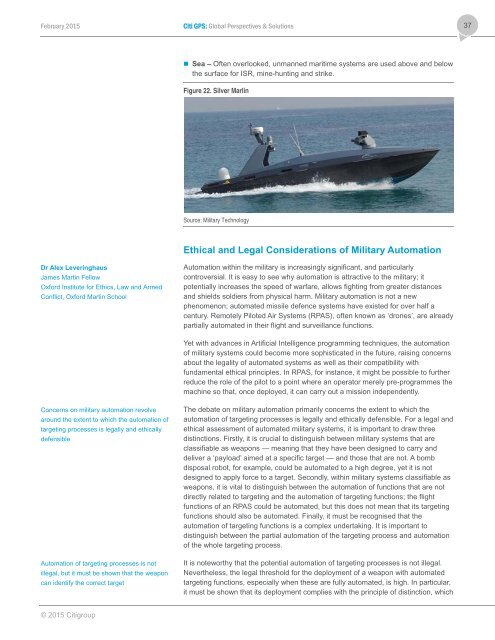TECHNOLOGY AT WORK
1Oclobi
1Oclobi
Create successful ePaper yourself
Turn your PDF publications into a flip-book with our unique Google optimized e-Paper software.
February 2015<br />
Citi GPS: Global Perspectives & Solutions<br />
37<br />
• Sea – Often overlooked, unmanned maritime systems are used above and below<br />
the surface for ISR, mine-hunting and strike.<br />
Figure 22. Silver Marlin<br />
Source: Military Technology<br />
Dr Alex Leveringhaus<br />
James Martin Fellow<br />
Oxford Institute for Ethics, Law and Armed<br />
Conflict, Oxford Martin School<br />
Concerns on military automation revolve<br />
around the extent to which the automation of<br />
targeting processes is legally and ethically<br />
defensible<br />
Automation of targeting processes is not<br />
illegal, but it must be shown that the weapon<br />
can identify the correct target<br />
Ethical and Legal Considerations of Military Automation<br />
Automation within the military is increasingly significant, and particularly<br />
controversial. It is easy to see why automation is attractive to the military; it<br />
potentially increases the speed of warfare, allows fighting from greater distances<br />
and shields soldiers from physical harm. Military automation is not a new<br />
phenomenon; automated missile defence systems have existed for over half a<br />
century. Remotely Piloted Air Systems (RPAS), often known as ‘drones’, are already<br />
partially automated in their flight and surveillance functions.<br />
Yet with advances in Artificial Intelligence programming techniques, the automation<br />
of military systems could become more sophisticated in the future, raising concerns<br />
about the legality of automated systems as well as their compatibility with<br />
fundamental ethical principles. In RPAS, for instance, it might be possible to further<br />
reduce the role of the pilot to a point where an operator merely pre-programmes the<br />
machine so that, once deployed, it can carry out a mission independently.<br />
The debate on military automation primarily concerns the extent to which the<br />
automation of targeting processes is legally and ethically defensible. For a legal and<br />
ethical assessment of automated military systems, it is important to draw three<br />
distinctions. Firstly, it is crucial to distinguish between military systems that are<br />
classifiable as weapons — meaning that they have been designed to carry and<br />
deliver a ‘payload’ aimed at a specific target — and those that are not. A bomb<br />
disposal robot, for example, could be automated to a high degree, yet it is not<br />
designed to apply force to a target. Secondly, within military systems classifiable as<br />
weapons, it is vital to distinguish between the automation of functions that are not<br />
directly related to targeting and the automation of targeting functions; the flight<br />
functions of an RPAS could be automated, but this does not mean that its targeting<br />
functions should also be automated. Finally, it must be recognised that the<br />
automation of targeting functions is a complex undertaking. It is important to<br />
distinguish between the partial automation of the targeting process and automation<br />
of the whole targeting process.<br />
It is noteworthy that the potential automation of targeting processes is not illegal.<br />
Nevertheless, the legal threshold for the deployment of a weapon with automated<br />
targeting functions, especially when these are fully automated, is high. In particular,<br />
it must be shown that its deployment complies with the principle of distinction, which<br />
© 2015 Citigroup










